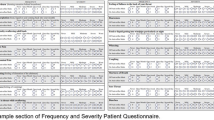Abstract
Background
The significance of laparoscopic Heller myotomy and Dor fundoplication (LHD) for the treatment of achalasia in relation to the severity of the lesion has not been sufficiently assessed.
Methods
Of patients who were diagnosed with achalasia from August 1994 to February 2004, 55 individuals who underwent LHD served as subjects. The therapeutic effects of LHD were assessed in terms of operation time, intraoperative complications, postoperative hospital stay, and symptom improvement in relation to morphologic type (spindle type, Sp; flask type, Fk; and sigmoid type, Sig). Degree of symptomatic improvement was classified into four grades: excellent, good, fair, and poor.
Results
Breakdown of morphologic type was as follows: Sp, n = 29; Fk, n = 18; and Sig, n = 8. Excluding one patient for whom conversion to open surgery was required, median average operation time for 54 patients was 160 min. As to intraoperative complications, esophageal mucosal perforation was seen in nine of the 55 patients (16%); however, conversion to open surgery could be avoided by suturing the affected area. Moreover, intraoperative bleeding of at least 100 g was seen in five of the 55 patients (9%), with one Fk patient requiring conversion to open surgery and transfusion. Median postoperative hospital stay was 8 days. Degree of dysphagia relief was excellent in 45 patients (83%), good in eight patients (15%), and fair in one patient (2%). Excellent improvement was obtained in 90%, 88%, and 50% in Sp, Fk, and Sig patients, respectively. Reflux esophagitis was seen in two patients, and was treated with a proton pump inhibitor.
Conclusions
The results of the present study suggest that classification of morphologic type is a useful parameter in predicting postoperative outcome in achalasia. In order to achieve excellent symptomatic relief, surgery for achalasia should be recommended for but not limited to Sp and Fk types.


Similar content being viewed by others
References
Bremner RM, DeMeester TR (1996) Current management of patients with esophageal motor abnormalities. Adv Surg 30: 349–384
Fernandez AF, Matinez MA, Ruiz J, Torres R, Faife B, Torres JR, Escoto CM (2003) Six years of experience in laparoscopic surgery of esophageal achalasia. Surg Endosc 17: 153–156
Finley RJ, Clifton JC, Stewart KC, Graham AJ, Worsley DF (2001) Laparoscopic Heller myotomy improves esophageal emptying and the symptoms of achalasia. Arch Surg 136: 892–896
Hunter JG, Trus TL, Branum GD, Waring JP (1997) Laparoscopic Heller myotomy and fundoplication for achalasia. Ann Surg 225: 655–665
Patti MG, Pellegrini CA, Horgan S, Arcerito M, Omelanczuk P, Tamburini A, Diener U, Eubanks TR, Way LW (1999) Minimally invasive surgery for achalasia. An 8-year experience with 168 patients. Ann Surg 230: 5875–5894
Pechlivanides G, Chrysos E, Athanasakis E, Tsiaoussis J, Vassilakis JS, Xynos E (2001) Laparoscopic Heller cardiomyotomy and Dor fundoplication for esophageal achalasia. Arch Surg 136: 1240–1243
Peracchia A, Bonavina L (2000) Achalasia:dilatation, injection or surgery? Can J Gastroenterol 14: 441–443
Rosati R, Fumagalli U, Bona S, Bonavina L, Pagani M, Peracchia A (1998) Evaluating results of laparoscopic surgery for esophageal achalasia. Surg Endosc 12: 270–273
Yamamura MS, Gilster JC, Myers BS, Deveney CW, Sheppard BC (2000) Laparoscopic Heller myotomy and anterior fundoplication for achalasia results in a high degree of patient satisfyaction. Arch Surg 135: 902–906
Zaninotto G, Annese V, Costantini M, Del Genio A, Costantino M, Epifani M, Gatto G, D’onofrio V, Benini L, Contini S, Molena D, Battaglia G, Tardio B, Andriulli A, Ancona E (2004) Randomized controlled trial of botulinum toxin versus laparoscopic Heller myotomy for esophageal achalasia. Ann Surg 239: 364–370
Zaninotto G, Costantini M, Molena D, Buin F, Carta A, Nicoletti L, Ancona E (2000) Treatment of esophageal achalasia with laparoscopic Heller myotomy and Dor partial anterior fundoplication: prospective evaluation of 100 consecutive patients. J Gastrointest Surg 4: 282–289
Acknowledgments
We specially thank Dr. Mitsuyoshi Urashima (Division of Clinical Research & Development, Jikei University School of Medicine) for statistical analysis.
Author information
Authors and Affiliations
Corresponding author
Rights and permissions
About this article
Cite this article
Omura, N., Kashiwagi, H., Ishibashi, Y. et al. Laparoscopic Heller myotomy and Dor fundoplication for the treatment of achalasia. Surg Endosc 20, 210–213 (2006). https://doi.org/10.1007/s00464-005-0365-5
Received:
Accepted:
Published:
Issue Date:
DOI: https://doi.org/10.1007/s00464-005-0365-5




